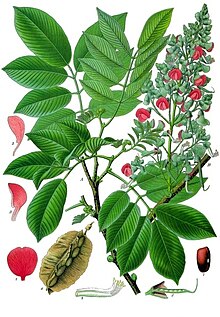| Piscidia | |
|---|---|

| |
| Piscidia piscipula | |
| Scientific classification | |
| Kingdom: | Plantae |
| Clade: | Tracheophytes |
| Clade: | Angiosperms |
| Clade: | Eudicots |
| Clade: | Rosids |
| Order: | Fabales |
| Family: | Fabaceae |
| Subfamily: | Faboideae |
| Tribe: | Millettieae |
| Genus: | Piscidia L., nom. cons. |
| Type species | |
| Piscidia piscipula (L.) Sarg.
| |
| Species[1] | |
|
7; see text | |
| Synonyms[1][2] | |
| |
Piscidia is a genus of flowering plants in subfamily Faboideae of the family Fabaceae.[2] It includes seven species of trees, and rarely shrubs, native to the tropical Americas, ranging from northern Mexico and Florida through Central America and the Caribbean to Venezuela and Peru. Typical habitats include seasonally-dry tropical forest, woodland, and bushland, often on rocky hills, with some species restricted to limestone substrates.[1]
The generic name is derived from the Latin words piscis, meaning "fish," and caedo, meaning "to kill." It refers to the use of extracts from the plant to poison fish.[3]
- ^ a b c Piscidia L. Plants of the World Online. Retrieved 14 September 2023.
- ^ a b "Taxon: Piscidia L." Germplasm Resources Information Network. United States Department of Agriculture. 2007-10-05. Archived from the original on 2009-05-07. Retrieved 2010-02-10.
- ^ Austin, Daniel F. (2004). Florida Ethnobotany. CRC Press. pp. 514–515. ISBN 978-0-8493-2332-4.